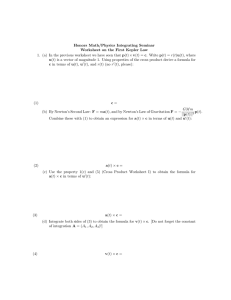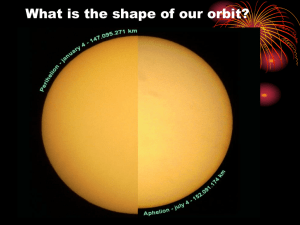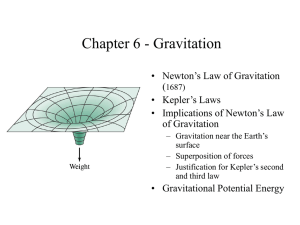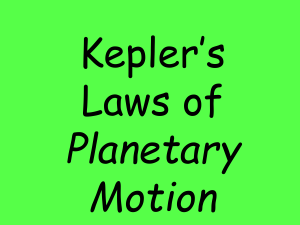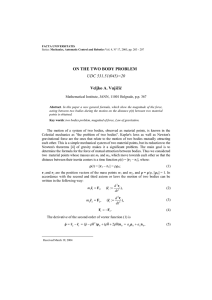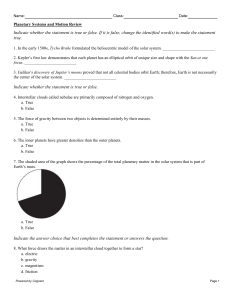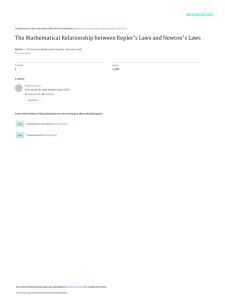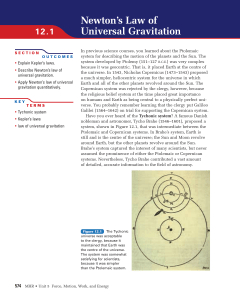Newton`s Law of Universal Gravitation
advertisement
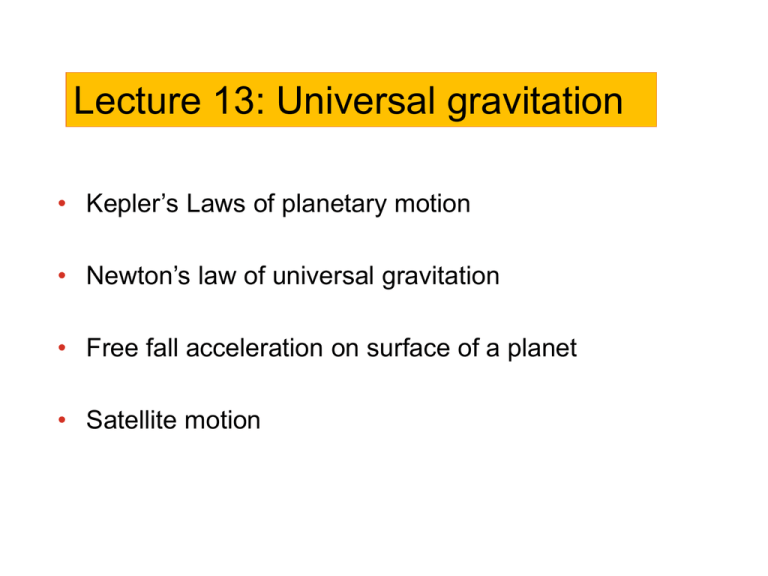
Lecture 13: Universal gravitation • Kepler’s Laws of planetary motion • Newton’s law of universal gravitation • Free fall acceleration on surface of a planet • Satellite motion Brief history of cosmology Ptolemy (85 - 165) geocentric theory Nicolaus Copernikus (1473-1543) heliocentric theory Tycho Brahe (1546-1601) Johannes Kepler (1571-1630) Laws of planetary motion Galileo Galilei (1564 - 1642) telescope discovered moons orbiting Jupiter observed phases of Venus Kepler’s Laws: 1st Law The planets move in elliptical orbits with the sun at one focus of the ellipse. http://www.walter-fendt.de/ph6en/keplerlaw1_en.htm Kepler’s 2nd Law A line drawn between the sun and a planet sweeps out equal areas in equal intervals of time http://www.walter-fendt.de/ph6en/keplerlaw2_en.htm Kepler’s 3rd law The square of a planet’s orbital period is proportional to the cube of the semi-major axis length. 𝑇 2 ∼ 𝑎3 Newton’s Law of Universal Gravitation 𝐹𝑔𝑟𝑎𝑣 𝐺𝑚𝑀 = 2 𝑟 𝐺 = 6.67 × 10−11 𝑁𝑚2/𝑘𝑔2 Universal gravitational constant Sir Isaac Newton (1643 - 1727) Gravitation near Earth’s surface 𝐹𝑔𝑟𝑎𝑣 𝐺𝑚𝑀 = 2 𝑟 But we used 𝑊 = 𝐹𝑔𝑟𝑎𝑣 = 𝑚𝑔 Force which Earth exerts on object of mass 𝑚 located close to Earth’s surface: 𝐺𝑚𝑀𝐸𝑎𝑟𝑡ℎ 𝐹𝑔𝑟𝑎𝑣 = 2 = 𝑚𝑔 𝑅𝐸𝑎𝑟𝑡ℎ 𝑔= 𝐺𝑀𝐸𝑎𝑟𝑡ℎ 𝑅𝐸𝑎𝑟𝑡ℎ 2 ⟶ Find free-fall acceleration on any planet of mass M and radius R Find mass of Earth 𝑔= 𝐺𝑀𝐸𝑎𝑟𝑡ℎ 𝑅𝐸𝑎𝑟𝑡ℎ If 𝐺 and 𝑅𝐸𝑎𝑟𝑡ℎ known: 2 𝑀𝐸𝑎𝑟𝑡ℎ 𝑔𝑅𝐸𝑎𝑟𝑡ℎ 2 = 𝐺 𝐺: Cavendish balance 𝑅𝐸 : Eratosthenes 200BC Satellite Motion 𝐹𝑥 = 𝐹𝑔𝑟𝑎𝑣,𝑥 = 𝑚𝑠𝑎𝑡 𝑎𝑥 =𝑚𝑠𝑎𝑡 (+𝑎𝐶 ) 𝐺𝑚𝑠𝑎𝑡 𝑀 𝑣2 = 𝑚𝑠𝑎𝑡 2 𝑅 𝑅 𝐺𝑀 2π𝑅 2 =𝑣 = 𝑅 𝑇 2 2 4π 𝑇2 = 𝑅3 𝐺𝑀 Kepler’s 3rd Law
